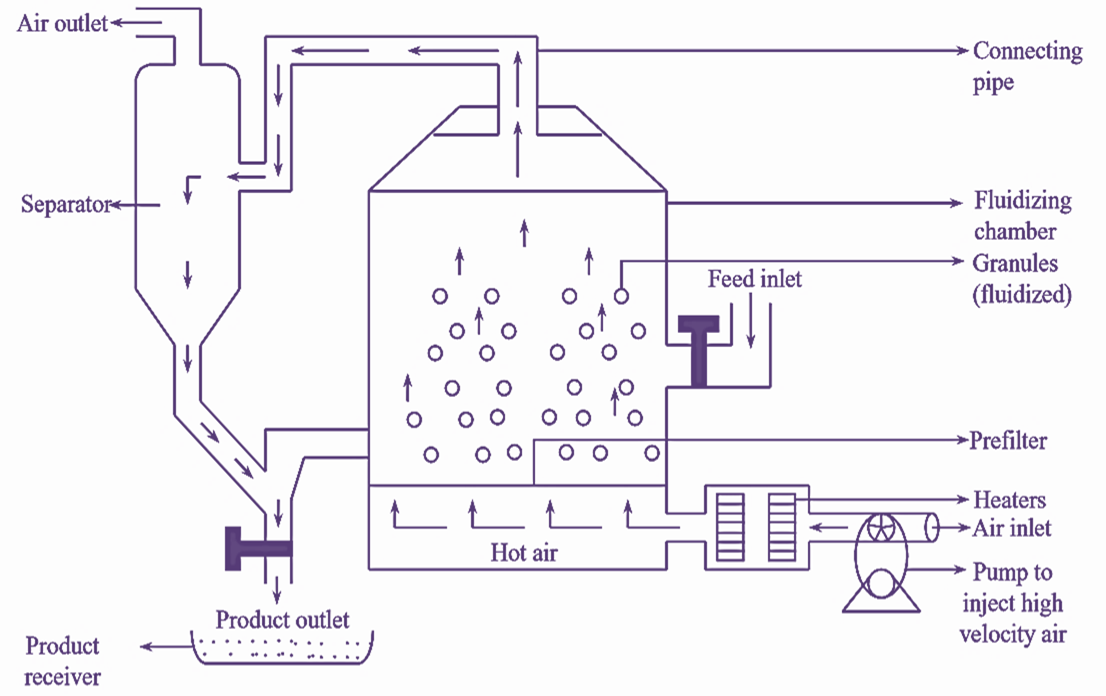
Figure 1: Fluidized Bed Dryer.
Working Principle of Fluidized Bed Dryer
Fluidized Bed Dryer works on the principle of fluidization. When hot air is passed through a granular bed (i.e., non-sticky wet granules), friction occurs between the granular surface and hot air, that leads to pressure drop (decrease in pressure). On increasing the velocity of air, the pressure increases and a point is attained at which the pressure is equal to the total weight of the granules. At this point, the granules get separated and further increase in velocity of hot air increases the motion of the granules and finally they get fluidized. Fluidization is a stage in which the granules are suspended in an air stream without any adhesion.
Construction of Fluidized Bed Dryer
It consists of a fluidization chamber made up of stainless steel. A pump is fitted at the bottom along with heaters such that the air entering the chamber gets heated. Feed inlet and product outlet are provided on either side. A pre-filter is fitted at the bottom (of chamber) below which an air inlet is present. Equipment also contains a separator (granule and air separator) which is used for collection of dried material from time chamber. Fluidized bed dryers without separator are also available which are mainly useful for batch type operations.
Working of Fluidized Bed Dryer
The material to be dried is placed into the fluidizing chamber through the feed inlet. Pump and the heaters are switched on. Hot air enters the chamber from the bottom through the pre-filter. The air flows from the bottom to the top with a high velocity such that the particles (granules) get suspended in the air stream and the fluidization is attained. Each particle is surrounded (entirely) by air, due to which effective drying is achieved. The particles remain fluidized for a period of about 1 to 2 minutes (if only surface liquid is to be dried) or 16 to 30 minutes (if water from interior of porous material is to be removed).
Solid particles of smaller size, ranging from 1-2.5 undergo fluidization. When coarse particles are to be dried, they must be mixed with a small quantity of fine particles for better fluidization. Similarly, addition of few coarse particles facilitates better fluidization of fine particles.
The dried particles move from the chamber to separator through a connecting pipe. Here, the air along with dust is eliminated and the dried material is collected from the product outlet (at the bottom). The presence of separator facilitates continuous operation.
In some fluidized bed dryers, separate (rectangular) compartments are present for fluidization. in which sequential flow of solids from inlet to outlet takes place, which is called as plug flow system. Cold air is circulated in the last compartment, due to which the material gets cooled before it is discharged.
Advantages of Fluidized Bed Dryer
- It is easy to handle and requires less time when compared to tray dryer.
- Low labour cost.
- High heat transfer coefficient.
- Drying can be done either batch-wise or continuous.
- Apart from drying, it can also be employed for coating, mixing and granulation etc.
- Thermal efficiency is much greater (2 to 6 times) when compared to tray dryer.
- It is suitable for both small and large scale drying.
- Drying capacity is more than tray dryer.
- Useful for thermolabile materials.
Disadvantages of Fluidized Bed Dryer
- Electrostatic charges may develop due to collision of particles, hence earthing of dryer is compulsory.
- Due to collision, granules may break, thereby forming fine particles.
- Not suitable for sticky materials.
Applications of Fluidized Bed Dryer
- It is an efficient method for drying granules.
- Solutions and slurries can be dried by suitable modifying the equipment.
- Modified fluidized bed dryer is used for coating of granules.